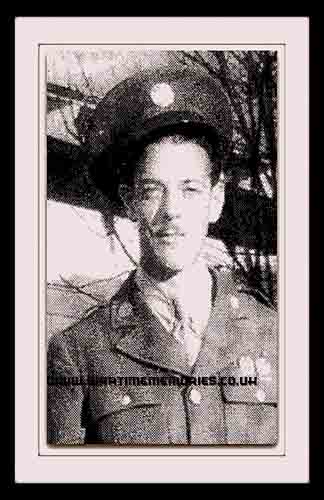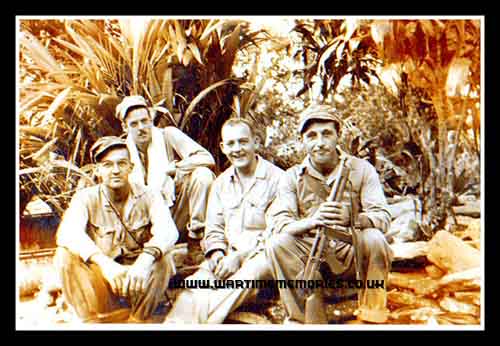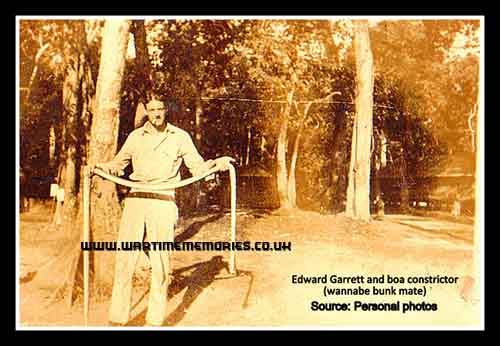Sgt. Edward Flagg Garrett 116th Quartermaster Corps
A Father’s WWII New Guinea Adventure
Occasionally, the internet puts out articles that rekindle memories of departed loved ones. The article I stumbled upon was from a June 7, 2010 CNN broadcast about an Australian explorer, a Captain Brian Freeman, who discovered in April 23 of the same year a pristine WWII battle site teeming with the bodies and equipment of Japanese soldiers along the Kokoda Trail, a mile from the village on Eora Creek in the jungle-thick, rugged Owens-Stanley mountain range of Papua, New Guinea.
The site has remained undisturbed because of a native fear that the area is haunted.
The relationship this article re-kindled was with my father, Edward F. Garrett, who died April 1997. A veteran of the New Guinea campaign of WWII, he was stationed at Port Moresby with the 116th Quartermaster Corps attached to the 41st Infantry Division, a site of extensive airfields and warehouses. (I came to this assessment because the transport ship closest to California was in Oregon, slated for use by the 41st regiment.)
His job was to load and unload supplies from incoming ships and planes. The GI’s and Aussies he worked with were to venture into the mountains either to block the advance of the Japanese or to mount a surprise attack on their base of operations in Buna-Gona, on the north-western side of the island
New Guinea, the world’s second largest island, is located on the eastern side of the Malay Archipelago just north of Australia in the southwest Pacific and sprawls over 786,000 km2. Encircled by three bodies of water—the Coral and Arafura seas and Torres Strait—New Guinea was once part of the Dutch East Indies; it owes its present name to the Dutch, who created one of the richest trading empires in the world. The thawing of the last ice age created the Torres Strait, separating Northern Australia from New Guinea.
Its most remarkable geographic feature is a spine of mountains running along the middle of its back, known as the Owens-Stanley mountain range, with a maximum elevation of 16,000 feet and a tree line rise to 13,000 feet. The southeastern side of that mountain chain was an Australian possession. The Japanese hoped to capture the eastern side’s main development, Port Moresby, via its stronghold on the opposite side of the island (Buna-Gona), as a staging ground for the invasion of Australia. In this, they were ill-advised by their Nay, who informed the Army that capture would be swift and easy because of a fully developed road cutting across the mountain.
I suppose, you could say that my father’s entry into New Guinea came by way of the trail his father had charted for him in WWI. My father’s middle name, Flagg, was his ancestral designation prior to adoption by the Garrett’s, his parents’ closest friends. His father, Edward Ernest, served in the trenches of WWI. Mustard gas weakened his lungs, making him susceptible at age 28, to the scourge of the time, tuberculosis. Perhaps, joining the service was my father’s s way of getting to know the father who died when he was just five years old.
Brian Freeman’s discovery of an intact Japanese camp not far from the Kokoda Trail triggered memories from my high school years. There, in the suburbs of Manila, at the dinner table, my father shared his New Guinea stories. His venture into Oceania, he opined, began when he was drafted in July of 1942. While on horseback in the remote suburbs of Los Angeles, he retrieved a letter from his jacket. It was an invitation to the big dance of his generation. It would send him to his first choice of service, the air force, but color blindness disqualified him and sent him to the US Army instead.
After basic training, he boarded a transport vessel headed for the Aleutians, where the Japanese had established a staging front for the invasion of Alaska and possibly the Northwest Coast. Low on provisions and in danger of imminent defeat, the Japanese launched a desperate banzai attack from their stronghold on Attu in late May of 1943. Their defeat and the abandonment of the last Aleutian foothold on Kiska, three months later, left my father’s detachment with an empty docket; they were subsequently rerouted to Australia.
“Suddenly”, he said, “We left the bitter, wild seas of the north, dumped winter gear, and donned tropical khakis”.
My father always sat at the head of the table. At the opposite end of it was a wall-sized mirror. From that vantage point, I watched him carve his steak, spearing each morsel with his fork, a task interrupted many times during his narrative. Married at age 27, he was in his early forties.
A tall man, about two inches taller than six feet, he sported thinning light brown hair and blue eyes. His lanky, athletic frame had been exaggerated by an imposing middle-age gut acquired from after-work beer busting at the BOQ. He rose to GS-12 in his job as procurement analyst at Subic Bay, a job that involved finding provisions for Navy ships. Like many others, he elected to stay in the Philippines after Liberation to help rebuild this nation of 7,000 islands.
“The journey from Alaska to Australia left most of us riding the rails, vomiting our dinner into the ocean. I spent most of the trip asleep on the only spot I could find on an overcrowded vessel, the coiled anchor chain. I was out of it and didn’t even consider what might happen had the ship dropped anchor. But finally our transport, came to port and I found myself hypnotized by New Guinea’s clear blue-green waters“.
His docking point was Port Moresby. A strong swimmer, my father wasted no time and doffed his uniform, measuring the distance to the pier, and dove. Up the ladder to the edge of the pier, he was greeted by an Aussie, who asked if he knew anything about the waters he had just braved. “Look, Mate!” he said pointing to a 20-foot tiger shark that had just cleared the pier where they were standing. “Shark-Infested,” he said, shaking his head.
“I should have learned something from that introduction to New Guinea, but I’m a slow learner.” He said, dipping a fry in ketchup.
I asked about the Japs, whether he had to fight any. He shook his head and said: “Nearest we came to a skirmish usually happened at in the dark morning hours after poker and lights out. Some Japanese stragglers, fallen away from their units, had become foragers of our kitchen, running off with potatoes, bread, whatever they could get their hands on. If spotted, the whole camp gave chase. If they made it to the jungle, they were good as gone.”
Once I asked my father what career he would have pursued had WWII not occurred. His answer: “Think I would’ve liked being a forest ranger.” My father had a love of nature and of animals that he nourished as a scout in Los Angeles, California. By his mid-teens he had risen to Eagle Scout. He took the strongest members of his unit with him into California’s snow-covered Baldy and Shasta mountains. He had worked as newsboy and grocery clerk. At Sears and Roebuck, he progressed to stocking clerk, roller skating back and forth across the warehouse.
He would have been more than ready for the task General McArthur, supreme allied commander in the Pacific, had envisioned for both 41st Jungle-ers and the 39th Aussie Battalion “Diggers”—to scale a 7,000 foot jagged tree-line, past snowy peaks--and then to descend into a shootout with camouflaged sniper and nested machine gun. The earliest Aussies to confront the Japanese wre nicknamed “Chocos” (for chocolate), a unit consisting of militia conscripts 21 and under, with little training and nonexistent combat toughening.
They were told their adventure into war would be easy. They could bring their tennis rackets and other athletic equipment. They were expected to melt in the heat of battle. Of the 600 who blocked the Japanese advance along the Kokoda Track only 142 survived.
“You could say it was a struggle between opposing forces in which weather, disease, and supply shortages played major roles,” he said.
Resisting the impulse to be diverted by a stray memory, my father continued. “We listened to Tokyo Rose a lot because she spoke English and played state-side music. That was the hook, but her real purpose was to demoralize us with false bad news about our skirmishes and battles. Occasionally, a lone zero would strafe us and dive bomb our positions, driving everyone into a mad scramble for trench and foxhole. Many took to sleeping in trenches on a makeshift bed of bamboo, a corrugated iron roof, and a mosquito net. We slept without shirt or pants, in underwear; the humidity was so high we were in constant drenching sweat.”
He spoke of his trove of war trophies he kept in a locker—katana, pistol, patches, helmet, canteen, rifle, a piece of very thin piece of aluminum with an emblazoned red sun that he had carved out of a downed zero with his bayonet. “Stolen. My locker was broken in, all items taken.” He said, shaking his head.
“Nope, our unit never fought the Japs. By definition, we were not designed for that function. Our fight involved finding supplies and provisioning our troops so they would be healthy enough to contend with the Japanese. We also had to deal with rain, mud, insects, and disease. Jungle rot threatened our feet. We hung our boots from a tripod or tree branch and shook them out before putting them on to keep from being stung by scorpions. Sometimes a drunk soldier forgot to check his cot just to run bare-assed out of his tent from a boa constrictor.”
A photographer by hobby, my father snapped photos of his stay in New Guinea. Many were of his war buddies, posing shirtless, dog tags glistening around their necks, cigarettes dangling from their lips. A few photos were of bare-breasted Mary’s, native women whose names were so unpronounceable the Aussies simply referred to them by that name. “They wore grass skirts, offering sexual favors in exchange for spam, sardines, hash, or beans. Surprising strong, native men, called fuzzy-wuzzies, were very helpful with carrying our cargo.”
A photo he should have taken was located on a hill, surrounded by razor-sharp grass and approachable only along an impassable mud-soaked road, the site natives did not recommend, calling it “humbug.” There army engineers built a hospital. “Our crew of engineers thought they were just a bunch of ignorant stone-age primitives, but we found out.”
“I recuperated in that hospital for about two weeks until I was fully recovered into early 44“. He summed up his medical ordeal in two words: Dengue Fever. “Given by mosquito sometime during my hike through kunai grass and jungle while hacking through rough bush creating a short-cut to my favorite clean and clear swimming hole.”
“At first, I thought I had measles”. He shook his head and continued. “I was feverish, wracked by headaches, and could hardly stand. My joints were sore. I was bed-ridden and on transfusions. The most I could manage was a bed pan and a letter to my folks. I was being sent cookies and chocolate but was afraid rats would eat my stash so I put my tin on a shelf mounted on a wall in front of my bed.”
Aside from sweets and letters from back home, the high point of his convalescence was a visit from his favorite general, Douglas McArthur, who was in his early 70’s and set to retire in the Philippines when WWII broke out. “I had always thought of generals as gods far removed from the concerns of the typical grunt, but here he was shaking my hand and wishing me a speedy recovery.” Later in McArthur’s ”I Shall Return” tour of liberated Manila, my father clicked the shutter of his Leica to record the speeches of McArthur and President Quezon at the Rizal memorial. Victory motorcades full of flag and handkerchief waving Filipinos, ecstatic with praise for their savior, lined the sides of the road. General McArthur was granted citizenship and many were eager to vote him into the highest office but he opted to take a commanding residence over Tokyo.
“But what about Humbug Hospital and your bout with dengue?” -
“Well, as you can probably tell, I survived it—but I was the only one. My fellow convalescents did not make it, thanks to scrub typhus. Seems putting that tin of goodies on a shelf saved my life. Those who put their stash under bed attracted the rats lived on that hill. Smelling the sweet plunder to be had under our hospital beds, they came at night, laden with typhus-bearing fleas. Everyone died. The hill was humbug. “
Eventually, General McArthur plans for retaking the Philippines through New Guinea landed my father at Leyte and from there to Manila, where the Japanese were defeated by his top commander, Major General Robert Eichelberger. Remnants of the Japanese Navy made their final stand at the old walled Spanish city of Intramuros whose walls were 8-feet thick and 22-feet tall. “The Japanese, fearing reprisal for their cruelty, had massacred everyone in the city. But they were blasted out with armor piercing howitzer and cannon shells. Once in a while, after the war, a few Japanese soldiers who had escaped the merciless revenge of the locals would be lured out by hunger from the walled city’s labyrinth of underground tunnels only to be spotted and tracked down. Most refused to surrender, hid, and were sealed in with the help of bull dozers.”
The garrison of Fort Santiago, part of the Intramuros complex, became the Army’s new supply warehouse. “I drove 6 by 6 trucks and forklifts moving 55-gallon drums and various pallets for storage and delivery.”
After the war, my father worked at Fort Santiago, also the Army’s main headquarters in post Liberation Manila.
Source: Google Images
He began as a tech sergeant and ended his Army career as a master sergeant in June of 1947. Eventually, Fort Santiago was rededicated to a museum honoring Jose Rizal, the foremost hero and martyr of the Filipino revolt against Spain.
I look at the pictures Captain Bryan Freeman took—the rusted helmets, shell casings, grenades, and machine guns—and wondered why McArthur had taken a less direct route for his return to the Philippines.
The answer, I discovered, was Australia. The Japanese Empire was poised for a takeover of Australia and had been bombing Darwin. Only Port Moresby’s landing docks and airstrips stood against the Japanese threat. In this, Buna-gona, the Japanese air force and fleet were the main threats. The Battle of the Coral Sea dealt a serious blow to their Navy and the Battle of Midway did the same to their Air Force. That left only the Army and their harrowing venture up Kokoda Track.
Allied strategy for the defeat of Japan in New Guinea involved taking Buna-Gona, Lae, and the rest of West New Guinea, and finally, Rabaul, heavily fortified main Japanese headquarters for their Oceania offensive. The plan seemed circuitous at first but the intent was to protect Australia and then eliminate the threat of reinforcements from the New Guinea sector. Once Oceania had been secured, the route to Leyte was open. By then the Japanese Air Force and Navy would have been reduced to an ineffective and fragmented force.
Charles I. Anderson, in his brochure for the Center of Military History, summed up allied strategy.
Working with the Australian Chiefs of Staff, General MacArthur prepared a joint estimate of the situation. The Allies agreed that the Japanese advance would continue and that it would soon threaten the Australian supply line as well as the island nation itself. As General MacArthur viewed the situation, the best way to defend Australia was to meet the Japanese on New Guinea, and the way into New Guinea lay through Port Moresby, a harbor on the southeast Papuan coast lightly garrisoned by Australians. Accordingly, in early April MacArthur directed the reinforcement of Port Moresby.
Unbeknownst to my father, forces were at play that would alter the course of his life, taking him from the west coast of the United States to the southern hemisphere, the world’s second largest island, its steamy climate of bugs, mud, and rain. Between him and his buddies lay the Kokoda Trail, the link connecting Allied and Axis combatants. His fight however, would be a different kind of battle. He would fight dengue fever and a hospital climate that posed its own invisible dangers. But he would survive dengue and sidestep direct hostile action and arrive in the Philippines where he would marry, raise a family, and help rebuild a fledgling democracy. His was not the path of violence. For that, his father had already paid the price.








